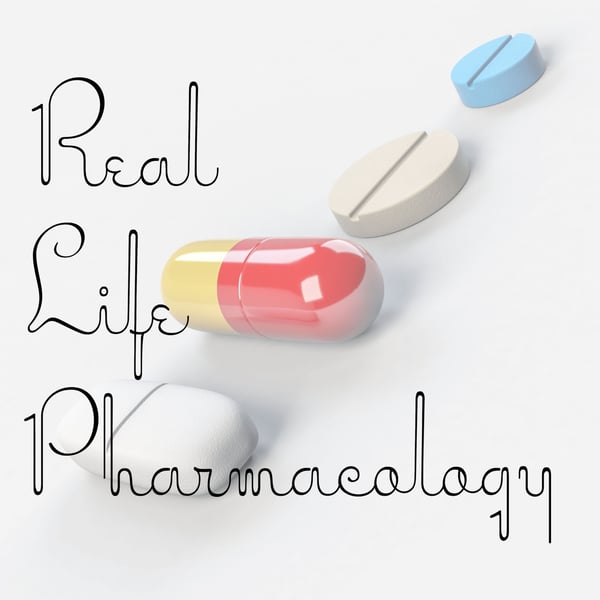Propranolol Pharmacology
Real Life Pharmacology - Pharmacology Education for Health Care Professionals
Eric Christianson, PharmD; Pharmacology Expert and Clinical Pharmacist
5 • 716 Ratings
🗓️ 9 September 2021
⏱️ 14 minutes
🧾️ Download transcript
Summary
Propranolol (Inderal) is a non-selective beta-blocker. There are many indications for it including hypertension, tachycardia, atrial fibrillation, post-MI, chronic stable angina, essential tremors, migraine prophylaxis, esophageal varices, performance anxiety disorder, lithium-induced tremor, psychotic induced akathisia, and thyroid storm.
Propranolol blocks beta-1 receptors that are commonly referred to as the cardiac receptors and beta-2 receptors that are in the lungs. Albuterol is a beta-2 agonist meaning that propranolol can block its effects. This may lead to bronchospasms and worsening of respiratory conditions. This is one of the major issues when using a non-selective beta-blocker vs a selective one.
Other adverse effects include a drop in blood pressure and pulse. Fatigue is also seen in many geriatric patients so it is important to be titrating them up slowly. If you notice patients increasing caffeine intake, starting a stimulant, or experiencing new depression symptoms that can be a sign of fatigue. Sexual dysfunction has also been seen in patients taking propranolol. Propranolol may mask symptoms of hypoglycemia. Closely monitor patients that are taking insulin and/or sulfonylureas. Abrupt discontinuation can increase the risk for acute coronary syndromes, especially if the patient is already at risk. Make sure that the medication is taken consistently and there aren’t periods of multiple missed doses.
Propranolol comes in multiple dosage forms that have been mixed up. When dispensing or administering take extra caution that the medication is correct.
Propranolol is a weak CYP1A2 inhibitor that could increase concentrations of tizanidine or theophylline. Propranolol also gets broken down by CYP1A2. Medications that inhibit this enzyme can increase the concentration of propranolol. Examples of these are ciprofloxacin and fluvoxamine. Inducers of CYP1A2 can reduce concentrations. These are rifampin, carbamazepine, and phenobarbital. A unique CYP1A2 inducer is smoking tobacco. Medications can cause additive effects when it comes to blood pressure and pulse. Be careful with any blood pressure-lowering medications including antihypertensives, PDE5 inhibitors (sildenafil), and Parkinson’s medications (Sinemet). Drugs that can lower pulse include centrally acting alpha 2 antagonists (clonidine) and acetylcholinesterase inhibitors (donepezil, rivastigmine).
Transcript
Click on a timestamp to play from that location
| 0:00.0 | Hey, all, welcome back to the Real Life Pharmacology podcast. I'm your host, pharmacist, Sarah Christensen, |
| 0:05.5 | and I thank you so much for listening today. As always, go check out Real Life Pharmacology.com |
| 0:11.8 | Just by subscribing via email, we'll get you a 31-page PDF on the top 200 drugs. |
| 0:18.6 | Great refresher if you're out in clinical practice, as well as if you're |
| 0:24.2 | taking pharmacology courses or taking board exams soon. Definitely, I think, a helpful, |
| 0:30.4 | a real-world kind of experience where I shared my most important clinical pearls with those top |
| 0:37.1 | 200 drugs. |
| 0:38.2 | So you get that absolutely for free for subscribing to real life pharmacology.com. |
| 0:43.4 | And obviously we'll get you updates on. |
| 0:45.0 | We've got new content, new podcasts, and things available too. |
| 0:48.0 | So again, go check that out, real life pharmacology.com. |
| 0:53.0 | All right. |
| 0:53.5 | So let's do the drug of the day today, and that is propranol. |
| 0:58.8 | Brand name of this medication is Indurol. And in clinical practice, I feel like I'm seeing it |
| 1:06.2 | less and less, but there definitely are certain circumstances that I do feel that I see it from time |
| 1:14.3 | to time for sure. |
| 1:15.5 | So this drug is a non-selective beta blocker. |
| 1:20.9 | We did a general overview of beta blockers, but I definitely wanted to dig down into a little |
| 1:26.7 | bit more specifics with |
| 1:28.3 | propranolol specifically here. So it has, if you look it up, it has tons of indications. |
| 1:36.6 | Hypertension, you know, tachycardi atrial fibrillation, post-MI, chronic stable angiosol, |
| 1:43.4 | lots of cardiovascular indications. |
... |
Please login to see the full transcript.
Disclaimer: The podcast and artwork embedded on this page are from Eric Christianson, PharmD; Pharmacology Expert and Clinical Pharmacist, and are the property of its owner and not affiliated with or endorsed by Tapesearch.
Generated transcripts are the property of Eric Christianson, PharmD; Pharmacology Expert and Clinical Pharmacist and are distributed freely under the Fair Use doctrine. Transcripts generated by Tapesearch are not guaranteed to be accurate.
Copyright © Tapesearch 2025.

